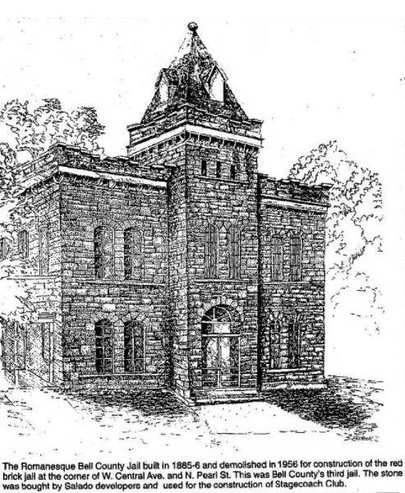Early Bell County Jail
Introduction
Text-to-speech Audio
This building served as Bell County's jail and was the scene of several acts of vigilante justice. In the Reconstruction period between 1865 and 1877, corruption, lawlessness, and racial divides were rampant in Bell County. Mob violence erupted on many occasions and the jail was often at the center of the conflict. This was the case on May 25, 1874, one of the most violent days in the history of Bell County.
Images
Early Bell County Jail

Early Bell County Jail

Original limestone

Historical marker

Belton Jail Prisoners Grave at South Belton Cemetery

Backstory and Context
Text-to-speech Audio
Bell County's second jail was located at 201 N. Pearl Street. The building witnessed one of the most violent vigilante acts in Texas history. During and after the Civil War, deserters from both sides of the conflict, as well as outlaws and thieves, flocked to the cedar breaks and caves around Bell County. Lawlessness, theft, and other criminal acts abounded until the night of May 25, 1874. While the sheriff was away on official business, a mob of one hundred vigilantes from throughout Texas rode into Belton, tied up the jailer, broke the five-pound lock, and proceeded to gun down nine prisoners convicted of horse theft and murder.
The incident is recorded in Story of Bell County, Texas, published in 1988, which includes three accounts from Waco newspapers: one by Dayton Kelley from 1966 and two published in May 1874. Eight of the men were accused of horse theft; the ninth had allegedly killed his wife in Coryell County. In late May, 1874, the Waco Advance listed the names of the dead: John Alexander (alias Daily), William Henry Grumbles, William S. Smith, J.S. McDonald, Marion McDonald, and Lloyd Colman, the alleged wife-killer. Three other victims--Wingfield, Beckneal and Crow-- are remembered by their surnames only. A 10th member of the group, Tyre Thompson, escaped death because illness had caused him to be moved to another area of the jail; he was later tried and given a life sentence, according to Judge George W. Tyler in his 1936 History of Bell County.
According to one version of the incident, bodies of the dead men were to be carried to a cemetery (now known as South Belton Cemetery) for burial in a common grave; however, the county's presiding justice E. Walker apparently decided against this course and ordered separate coffins and graves for the men. On May 26, 1874, according to court records, John H. Johnson was authorized $70.55 for burial of the nine men "recently killed in the county jail." Johnson and Isaac Williams were also allowed $15 for "superintending" the burial of the nine dead men. On September 29, Charles A. Wear was "allowed $6 for painting the names of the nine murdered prisoners on their headboards."
Sources
Limmer, E. A., Jr. Story of Bell County, Texas. Austin, TX.: Eakin Press, 1988.
Belton Chamber of Commerce. Belton: National Historic District Walking Tour, 2001.
Tyler, George W. The History of Bell County. Belton, Texas: Dayton Kelly, 1966.
Belton Journal 10.12.2000
Photo by Terry Jeanson, 2007
Photo by Jerry Jeanson, 2007
Photo by Terry Jeanson, 2007
Photo by Chris Varville
